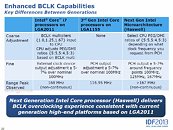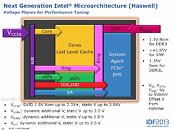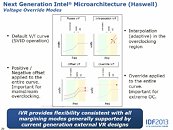- Joined
- Oct 9, 2007
- Messages
- 47,298 (7.53/day)
- Location
- Hyderabad, India
| System Name | RBMK-1000 |
|---|---|
| Processor | AMD Ryzen 7 5700G |
| Motherboard | ASUS ROG Strix B450-E Gaming |
| Cooling | DeepCool Gammax L240 V2 |
| Memory | 2x 8GB G.Skill Sniper X |
| Video Card(s) | Palit GeForce RTX 2080 SUPER GameRock |
| Storage | Western Digital Black NVMe 512GB |
| Display(s) | BenQ 1440p 60 Hz 27-inch |
| Case | Corsair Carbide 100R |
| Audio Device(s) | ASUS SupremeFX S1220A |
| Power Supply | Cooler Master MWE Gold 650W |
| Mouse | ASUS ROG Strix Impact |
| Keyboard | Gamdias Hermes E2 |
| Software | Windows 11 Pro |
At the Intel Developer Forum (IDF) 2013 event held in Beijing last week, the company ran two separate seminars related to "Haswell," one related to the micro-architecture itself, and the other overclocking it. The company detailed improvements to the ways in which you can overclock these chips, without necessarily having to shell out dough for the base clock multiplier unlocked "-K" parts.
To begin with, tweaking Core "Haswell" processors will be similar to tweaking Core "Sandy Bridge-E" high-end desktop (HEDT) platform. Naturally then, overclocking "non-K" parts will be similar to overclocking the Core i7-3820. The chips ship with a base clock speed of 100 MHz. As with "Ivy Bridge," not just CPU cores, but also certain uncore components rely on this frequency. Also, as with "Ivy Bridge," overclockers will be given 5 to 7 percent headroom for tweaking this frequency, but it doesn't end there.



As with Intel's HEDT platforms, not only will you be given up to 7 percent overclocking headroom to the 100 MHz default base clock, but also given the freedom to choose between three base clocks: 100 MHz, 125 MHz, and 166 MHz. The various other uncore frequency ratios will adjust themselves to compensate, and stability of these uncore components will remain unaffected.
At each of these base clocks, you will be given the same 5 to 7 percent overclocking headroom, so in theory, you could get a chip to run with a base clock of 173 MHz, while adjusting other ratios. The reason Intel cites you can't deviate from the 7 percent headroom, is that it could destabilize two important clock domains, PCI-Express and DMI-PLL. With unlocked "-K" chips, you get the freedom to step up base clock multiplier for the CPU cores all the way up to 80.0x for 100 MHz, up to 64.0x for 125 MHz, and up to 48.0x for 166 MHz; which if used right, could result in some awesome CPU clock speeds in the neighborhood of 8.00 GHz.
Clock speeds, multiplers, and ratios are only a part of the overclocking story, keeping them stable is the job of skillfully selecting the right voltages for the various power domains. With "Haswell," Intel is introducing integrated voltage regulation (iVR). Simply put, each processor comes with an integrated VRM controller, which ensures overclockers don't have to keep up with the ways in which VRM is implemented on different brands of motherboards. You'd still need a high-end motherboard with high-grade VRM components (chokes, capacitors, and FETs), yet the ways in which you tweak them will be more standardized. So just don't expect to be able to chase an 8.00 GHz record with a $60 motherboard.
The iVR design ensures that motherboards feed processors with just two power domains, vCCIN, and vDDQ. iVR takes input from vCCIN, and regulates it to vCORE (feeds CPU cores), vRING (feeds the ring-bus that interconnects everything on the processor), vSA/vIOA/vIOD (feed system agent or integrated-northbridge, and certain other uncore components), and vGT (feeds the integrated graphics processor). Ranges for these domains are detailed in the slide below.


View at TechPowerUp Main Site
To begin with, tweaking Core "Haswell" processors will be similar to tweaking Core "Sandy Bridge-E" high-end desktop (HEDT) platform. Naturally then, overclocking "non-K" parts will be similar to overclocking the Core i7-3820. The chips ship with a base clock speed of 100 MHz. As with "Ivy Bridge," not just CPU cores, but also certain uncore components rely on this frequency. Also, as with "Ivy Bridge," overclockers will be given 5 to 7 percent headroom for tweaking this frequency, but it doesn't end there.



As with Intel's HEDT platforms, not only will you be given up to 7 percent overclocking headroom to the 100 MHz default base clock, but also given the freedom to choose between three base clocks: 100 MHz, 125 MHz, and 166 MHz. The various other uncore frequency ratios will adjust themselves to compensate, and stability of these uncore components will remain unaffected.
At each of these base clocks, you will be given the same 5 to 7 percent overclocking headroom, so in theory, you could get a chip to run with a base clock of 173 MHz, while adjusting other ratios. The reason Intel cites you can't deviate from the 7 percent headroom, is that it could destabilize two important clock domains, PCI-Express and DMI-PLL. With unlocked "-K" chips, you get the freedom to step up base clock multiplier for the CPU cores all the way up to 80.0x for 100 MHz, up to 64.0x for 125 MHz, and up to 48.0x for 166 MHz; which if used right, could result in some awesome CPU clock speeds in the neighborhood of 8.00 GHz.
Clock speeds, multiplers, and ratios are only a part of the overclocking story, keeping them stable is the job of skillfully selecting the right voltages for the various power domains. With "Haswell," Intel is introducing integrated voltage regulation (iVR). Simply put, each processor comes with an integrated VRM controller, which ensures overclockers don't have to keep up with the ways in which VRM is implemented on different brands of motherboards. You'd still need a high-end motherboard with high-grade VRM components (chokes, capacitors, and FETs), yet the ways in which you tweak them will be more standardized. So just don't expect to be able to chase an 8.00 GHz record with a $60 motherboard.
The iVR design ensures that motherboards feed processors with just two power domains, vCCIN, and vDDQ. iVR takes input from vCCIN, and regulates it to vCORE (feeds CPU cores), vRING (feeds the ring-bus that interconnects everything on the processor), vSA/vIOA/vIOD (feed system agent or integrated-northbridge, and certain other uncore components), and vGT (feeds the integrated graphics processor). Ranges for these domains are detailed in the slide below.


View at TechPowerUp Main Site








